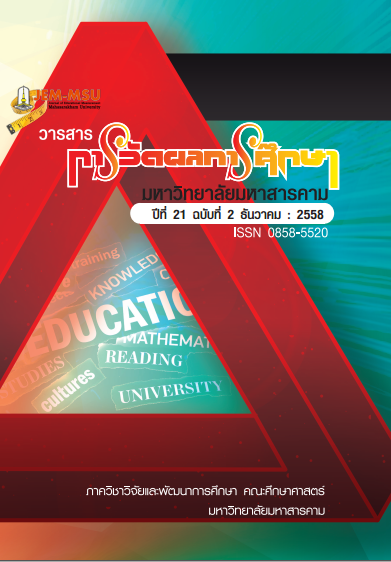Relationship Of Variables With The Ability to Solve Mathematics Problems Of Matthayomsueksa 3 Students in Buriram Province
Main Article Content
Abstract
One of the main aims of organizing mathematics learning is to enable
students to solve mathematical problems which is a foundation used to develop
thinking methods and enhances their abilities in solving daily problems. In organizing
Mathematics learning, there are several relevant factors that relate to mathematics
problem-solving ability of students. This study was aimed at investigating relationship
between factors affecting mathematics problem-solving ability and constructing
predictive equations for mathematics problem-solving ability. The sample consisted of
370 Matthayomsueksa 3 students from 8 schools selected by multi-stage random
sampling method. Two research instruments used in this study were the four tests the
rating scale test and as follows. The first test was a 4-multiple choice test with 40
items to investigate mathematics problem-solving ability with the difficulty ranged
from .32 to .72, the discrimination ranged from .23 to .92 and the reliability of .892.
The second was 12-item reasoning ability test with the difficulty ranged from .40 to
.72, the discrimination ranged from .39 to .85 and the reliability of .453, The third was
12-item English Abilities test with the difficulty ranged from .36 to .66, the discrimination
ranged from .23 to .69 and the reliability of .349, The fourth was 12-item figure test
with the difficulty ranged from .36 to .64 and the discrimination ranged from .23 to .69,
and the reliability of .370 The 5-rating scale of factors affecting mathematics problemsolving ability test consisted of 4 sections and there were12 items in each section. The
first section investigated learning attention, the second section examined attitudes
towards mathematics, the third section explored self-concept and the fourth section
studied teaching quality with the discrimination ranged from .645 to .923 and the
reliability of .962. The statistic applied in this study was Stepwise Multiple Regression
Analysis.
The results of the study were as follows:
1. The results of the multiple correlation coefficients among each predictive
variable and criterion variable via stepwise selection revealed all predictive variables
were positively associated with the criterion variables at the level of significance of .01.
The predictive variable associated with the criterion variable at the highest was
teaching quality (X7) with the correlation coefficient of .933. The predictive variable associated with the criterion variable at the lowest was self-concept (X6) with the
correlation coefficient of .820.
2. The results of the predictive equations for mathematics problemsolving ability of Matthayomsueksa 3 students in Buriram Province revealed that the
four predictive variables including teaching quality (X7), reasoning ability (X1), learning
attention (X4) and attitudes towards mathematics (X4) affected mathematics problemsolving ability (Y) in terms of raw scores and standard scores as follows.
Raw Score Regression Equation:
Y/= 4.794 + .540X7 + .751X1 + .220X4 + .401X5
Standard Score Regression Equation:
Z/
y = .960Z7 + .259Z1 + .366Z4 + .608Z5
Article Details
The content and information contained in the published article in the Journal of Educational Measurement Mahasarakham University represent the opinions and responsibilities of the authors directly. The editorial board of the journal is not necessarily in agreement with or responsible for any of the content.
The articles, data, content, images, etc. that have been published in the Journal of Educational Measurement Mahasarakham University are copyrighted by the journal. If any individual or organization wishes to reproduce or perform any actions involving the entirety or any part of the content, they must obtain written permission from the Journal of Educational Measurement Mahasarakham University.


